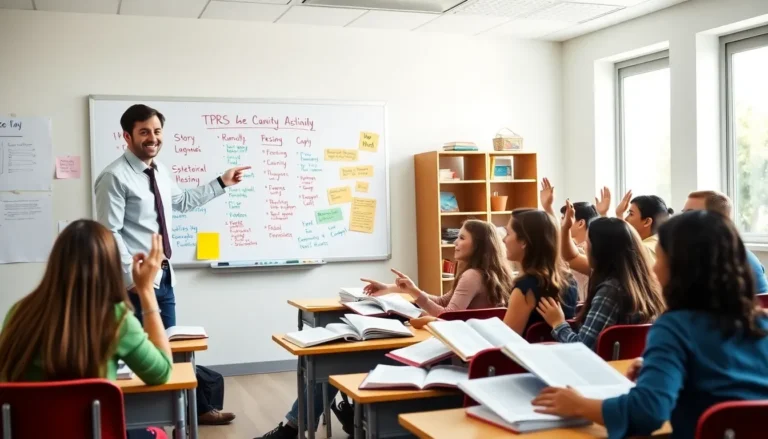Table of Contents
ToggleImagine trying to learn to swim without ever getting wet. Sounds ridiculous, right? That’s exactly what happens when learners dive into a new language without sufficient target language exposure. It’s like trying to bake a cake without ever cracking an egg. They need to immerse themselves in the sounds, rhythms, and quirks of the language to truly grasp its essence.
Understanding Target Language Exposure
Target language exposure refers to the amount and quality of interaction a learner has with the language they are acquiring. Immersive experiences play a crucial role in this process, enhancing familiarity with the language’s unique features.
Definition of Target Language Exposure
Target language exposure encompasses the various ways learners interact with the language. This includes listening to conversations, engaging in dialogues, reading texts, and incorporating multimedia resources. Engaging with authentic materials, such as films or podcasts, often proves beneficial. Regular practice leads to improved comprehension and fluency. Exposure isn’t solely about quantity; quality interactions deepen understanding, enabling learners to grasp subtleties and cultural nuances.
Importance in Language Acquisition
Target language exposure significantly influences language acquisition effectiveness. Research indicates that learners who receive ample exposure tend to achieve higher proficiency levels. Natural contexts encourage learners to use language instinctively, fostering spontaneous communication. Frequent interactions with native speakers enhance pronunciation and conversational skills. Consistent exposure builds confidence, allowing learners to express themselves more naturally. The variety in exposure, such as dialects or slang, enriches language learning, creating a more comprehensive understanding.
Types of Target Language Exposure
Target language exposure can occur through various methods, primarily categorized into naturalistic and structured exposure. Both types play essential roles in language acquisition.
Naturalistic Exposure
Naturalistic exposure takes place in real-life contexts. Learners immerse themselves in environments where the target language is spoken. Engaging with native speakers, watching films, or listening to music fosters authentic interaction. Conversations encountered in everyday situations often help learners absorb vocabulary and pronunciation naturally. Research indicates that individuals who spend significant time in language-rich settings demonstrate increased fluency and comprehension. Environments rich in sensory experiences, such as markets or community events, enhance the ability to understand cultural nuances alongside language.
Structured Exposure
Structured exposure involves organized methods of interacting with the target language. Formal classes, language apps, or guided conversation groups provide systematic learning opportunities. These settings often include targeted exercises focusing on grammar, vocabulary, and pronunciation. Utilizing textbooks and workbooks further strengthens foundational skills. Many learners benefit from this approach as it provides clarity and a structured learning path. Engagement with educational resources ensures consistent practice, while assessments track progress. This method complements naturalistic exposure, creating a balanced and comprehensive language learning experience.
Factors Influencing Target Language Exposure
Target language exposure significantly affects language acquisition effectiveness. Various factors, including age and frequency of interaction, play crucial roles in shaping a learner’s experience.
Age and Language Learning
Age influences language learning capacity. Young learners often grasp new languages more easily than older individuals. Research supports that children’s brains are naturally predisposed to absorb language, leading to enhanced pronunciation and comprehension skills. Adolescents and adults, however, can still achieve proficiency with consistent practice. Motivation remains key for older learners. As they engage with the target language, practice opportunities become vital for overcoming age-related challenges.
Frequency and Context of Exposure
Frequency of exposure directly impacts language proficiency. Daily interactions in the target language foster better retention of vocabulary and grammatical structures. Immersive environments yield the best results, as learners engage organically with native speakers. Context also matters; authentic materials such as movies, podcasts, and books offer cultural context that enriches understanding. Structured classes provide systematic exposure, ensuring learners receive essential language input. Varied experiences align to enhance overall language mastery.
Benefits of Target Language Exposure
Target language exposure offers numerous advantages for learners, notably relating to vocabulary, grammar, listening, and speaking skills. Each aspect contributes significantly to the overall mastery of a new language.
Improved Vocabulary and Grammar
Increased exposure leads to expanded vocabulary. Learners encounter new words in context, which aids in retention. Authentic materials feature diverse sentence structures, giving insight into grammar use. Resources such as films and articles reinforce this understanding. Frequent interactions with native speakers also create opportunities for practical language use. As vocabulary grows, learners naturally begin to apply grammatical rules in conversation. Research confirms that learners with ample exposure achieve improved proficiency metrics. Consistency in exposure solidifies language foundations, leading to fluent communication.
Enhanced Listening and Speaking Skills
Regular exposure sharpens listening skills through varied accents and speech patterns. Engaging with native speakers fosters an intuitive understanding of nuances. Conversational practice contributes to confidence in spoken language. Listening to podcasts or watching videos in the target language aids in recognizing common phrases. Authentic interactions prompt learners to respond naturally, reinforcing speech fluency. Structured environments like conversation groups further emphasize spoken practice. Each interaction improves pronunciation and facilitates better communication in real-world scenarios. Overall, immersive experiences develop listening comprehension and elevate conversation abilities.
Challenges in Achieving Target Language Exposure
Achieving target language exposure comes with several challenges that learners must navigate.
Limited Accessibility and Resources
Limited access to quality resources hampers language learners. Availability of native speakers often determines interaction opportunities. Learners in isolated areas may struggle to find conversation partners, pushing them towards less effective methods. Quality materials such as books, films, or podcasts also affect exposure. When resources are scarce, learners miss valuable contexts for vocabulary and grammar acquisition. Furthermore, structured programs may not reach every learner due to geographical or financial barriers, promoting inequities in language education. Engaging in online platforms can help bridge some gaps, but they don’t always replicate immersive experiences tied to cultural nuances.
Psychological Barriers to Exposure
Psychological factors often hinder learners from seeking out language exposure. Fear of making mistakes can discourage conversations with native speakers. Anxiety during interactions may prevent individuals from practicing effectively, stalling progress. Some learners might feel overwhelmed by the prospect of shifting into a new language environment. Self-doubt further complicates their willingness to engage. When learners lack confidence, they miss practical opportunities that foster language development. Recognizing these barriers is essential in creating supportive environments that encourage participation, as overcoming them can significantly enhance proficiency levels.
Target language exposure plays a crucial role in the journey of language acquisition. By immersing oneself in both naturalistic and structured environments, learners can significantly enhance their skills and confidence. The balance between engaging with authentic materials and participating in organized practices creates a rich learning experience.
Overcoming challenges like limited resources and psychological barriers is essential for maximizing exposure. With dedication and consistent effort, individuals can unlock the full potential of their language learning journey. Ultimately, embracing diverse opportunities for interaction will lead to greater proficiency and a deeper appreciation of the language and its culture.







